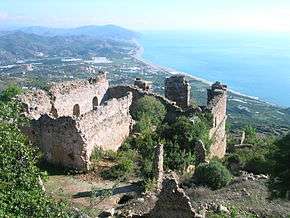Syedra
 Ruins of Syedra in 2007 | |
 Shown within Turkey | |
| Location | Antalya Province, Turkey |
|---|---|
| Region | Pamphylia |
| Coordinates | 36°26′28″N 32°9′9″E / 36.44111°N 32.15250°ECoordinates: 36°26′28″N 32°9′9″E / 36.44111°N 32.15250°E |
| Type | Settlement |
| History | |
| Founded | 7th century BCE |
| Abandoned | 13th century CE |
| Cultures | Greek, Roman, Byzantine |
| Site notes | |
| Condition | In ruins |
Syedra (Greek: Σύεδρα) was an ancient port city in the Pamphylia region on the southern coast of modern-day Turkey between the towns of Alanya and Gazipaşa. Syedra was settled in the 7th century BCE, and abandoned in the 13th century CE. The town had a port at sea level and an upper town 400m above.[1]
The Roman historians Lucan and Florus both mention Syedra as where the Roman General Pompey held his last war council in 48 BCE, before his fatal voyage to Egypt.[2] The city experienced its height around the 2nd and 3rd centuries CE, and in 194 Roman Emperor Septimius Severus praised the city's resistance of ongoing Mediterranean piracy.[3] A first century BCE inscription found in the town relates to the piracy, suggesting that the oracle, possibly of Apollo at Claros, advised the Syedrians to resist pirates with "violent battle, either driving away, or binding in unbreakable chains."[2][4]
Coins were minted in Syedra during various time periods going back to that of Roman Emperor Tiberius (r. 14 CE–37 CE).[5] In 374 CE, the early Christian theologian Epiphanius of Salamis wrote his work Ancoratus (the well anchored man) as a reply letter to the Church at Syedra, describing it as needing to be anchored in a safe harbor.[6]
Modern excavations began in 1994 under the Directorate of the Alanya Museum, and have excavated the main street in the upper town,[5] as well as a cave decorated with Christian imagery likely used for baptisms. A mosaic found is now on display in the Alanya Museum. Other structures include a temple, a theater, shops, bathhouse, town walls, and several cisterns that provided water to the city.[1] In 2011, archeologist excavating underwater dated relics of a port at Syedra to the Bronze Age, around 5,000 years ago.[7]
References
- 1 2 "Syedra". Ministry of Culture and Tourism. 2005. Retrieved April 9, 2015.
- 1 2 de Souza, Philip (2002). Piracy in the Graeco-Roman World. Cambridge University Press. pp. 139–140. ISBN 0-521-01240-6.
- ↑ "Syedra". Histolia (in German). February 22, 2015. Retrieved April 9, 2015.
- ↑ Price, S. R. F. (1999). Religions of the Ancient Greeks. Cambridge University Press. pp. 179–180. ISBN 0-521-38867-8.
- 1 2 "Syedra". Gelarabul (in Turkish). 2014. Retrieved April 9, 2015.
- ↑ Frank Williams, ed. (2009). The Panarion of Epiphanius of Salamis: Book I (sects 1–46). BRILL. pp. xv–xvi. ISBN 90-04-17017-0.
- ↑ "Relics of a 5,000-year-old port found in southern Turkey". World Bulletin. August 24, 2011. Retrieved August 29, 2011.
Further reading
- Elisabeth Rosenbaum; Gerhard Huber; Somay Onurkan: A survey of coastal cities in Western Cilicia. Preliminary report. Ankara 1967. S. 44–47. 65–66.
External links
 Media related to Syedra at Wikimedia Commons
Media related to Syedra at Wikimedia Commons- Coins found in Syedra
- Tourism info from VisitAlanya